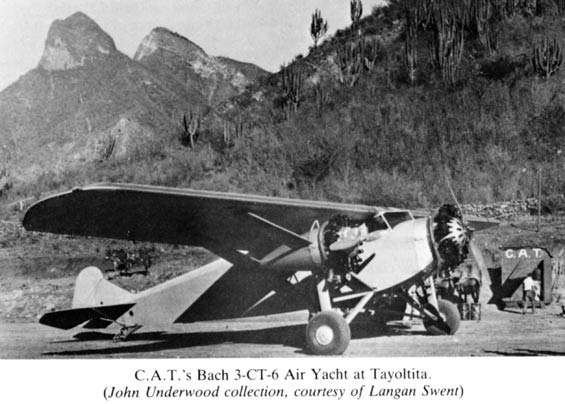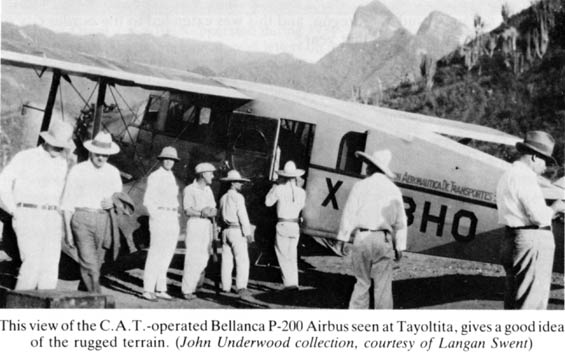Theodore T. Hull, date unknown
(Source: NASM)
 |
Theodore T. Hull was a banker who, at 36 years old, on March
9, 1929, formed the airline Corporacion
Aeronautica de Transportes S.A. (CAT) to operate from Brownsville, TX to Mazatlan and
from El Paso, TX to Mexico City. In late 1930, he opened
another line from Laredo, TX to Tampico, adding another important
U.S. border port as an air transportation terminal.
Hull was a prolific visitor to Tucson, landing at least
14 times between April 22, 1927 and March 25, 1930 as pilot
and passenger (e.g. with Bob
Starkey on April 5, 1929). Much
of his itinerary after 1929 was into Mexico and back. He
carried passengers about half the time.
He flew a variety
of aircraft, including Waco (aircraft number not identified),
Fairchild (NC8001, NC1772),
Boeing (a military model, A-7727), Ryan (NC7728)
and Lockheed (NC46M, NC2846, NC871E, NC2874,
NC504K and
the Mexican-registered X-ABH). The latter,
as well as the Ryan and some of the other Lockheeds, he bought
to operate on CAT.
He was inspected once by the U.S. Border Patrol on April 22, 1927. His itineraries in and out of Mexico probably led to the inspection by the relatively new (1924) Border Patrol organization.
In starting his business in Mexico, he did not scrimp on
the quality of his aircraft or the competence and talent
of the staff he hired to operate and maintain them. Paul
Braniff was one of the operations managers for Hull. Lloyd
Anderson (Register signer) was Chief Pilot. Harold
Bromley, his plans for a trans-Pacific flight delayed
by the crack-up of his “City of Tacoma”, took
a pilot position with Hull. R.S. Allen (reference in
right sidebar) cites Bromley delivering a brand new Vega to
Mexico during the autumn of 1929. This was very probably
NC2874, as recorded in the Register on August 23rd. Jack O’Brien
(Register signer), Wiley Post and Lowell
Yerex were also
pilots of the line. Mechanic/pilot Gordon
Barry also
worked with Hull. C.A.T. carried 2,283 passengers in
1930. The number almost doubled during the first half
of 1931.
The Davies reference in the right sidebar contains photographs of two of Hull's aircraft. The Bellanca P-200, XA-BHO (nee: NC684W, not a Register airplane) is below via Woodling, Davies and Underwood. Notice the terminal building.
Bellanca of C.A.T. In Service, Date Unknown (Source: See Text)
 |
Below, an unidentified Bach in C.A.T. service.
Bach of C.A.T. In Service, Date Unknown (Source: See Text)
 |
Hull died in an accident in Pennsylvania November 25, 1931
when he was ferrying a new Bellanca monoplane from Wilmington,
DE to Mexico. He had trouble over Sudbury, PA and crashed
full-speed into the Susquehanna River. C.A.T. remained
in operation for another couple of months, and then closed
because of bankruptcy (it was early in the Great Depression),
as well as strong competition from the growing Pan American
Airways system. His wife, Agnes, who was of the Fendrick Cigar family in Evansville, IN, survived him by many years.
Hull’s C.A.T. was envisioned as more than just an
airline into Mexico. His enthusiasm for the concept
led him to institute a master pilot’s scholarship in
aviation awarded annually to one Mexican youth selected by
competitive examination. The Hull scholarship was intended
to consist of an 18-months master pilot’s transport
course with primary training at a recognized aviation school
in the United States, and advanced training at the C.A.T.
base in Torreon, Mexico. The entire course was personally
prepared by Hull and Colonel Roberto Fierro.
The first examination was scheduled for October 1930. I
am not certain, given the demise of Mr. Hull a year later,
and the bankruptcy of the airline in early 1932, if the scholarship
program was ever instituted, or if it was, if the first student
ever graduated. Does anyone KNOW?
---o0o---
Dossier 2.1.101
THIS PAGE UPLOADED: 05/18/07 REVISED: 11/22/07, 12/22/07, 11/18/08, 04/29/12
|




